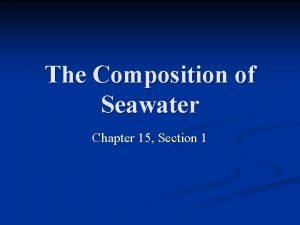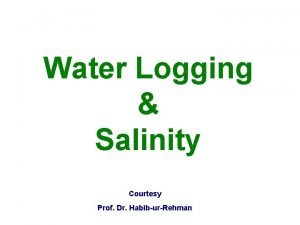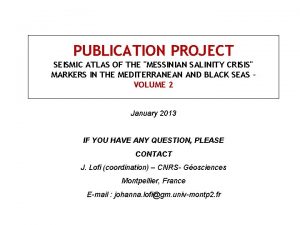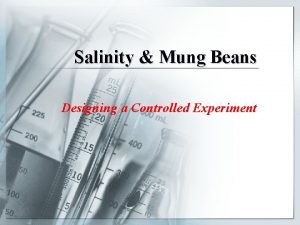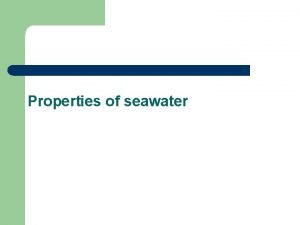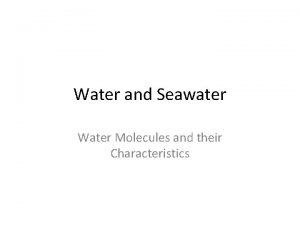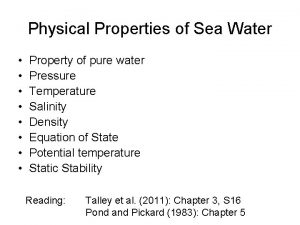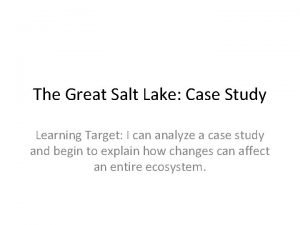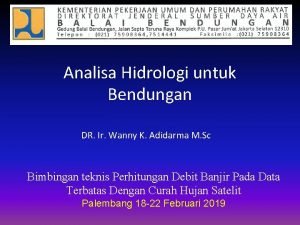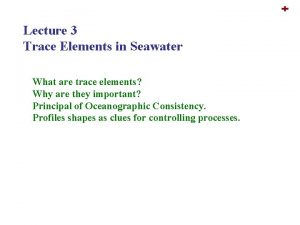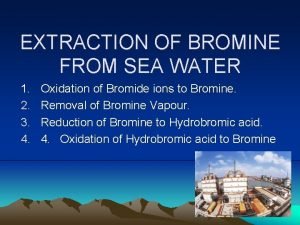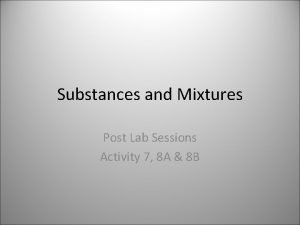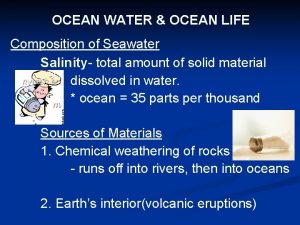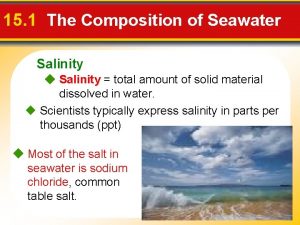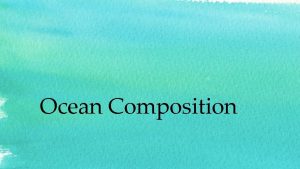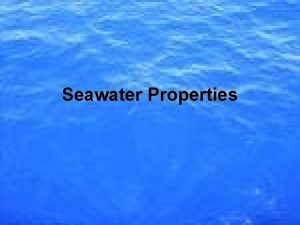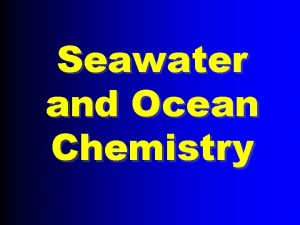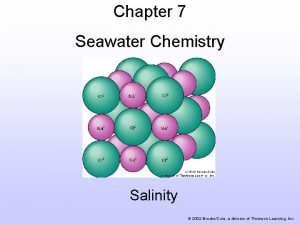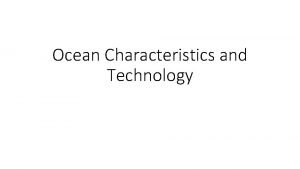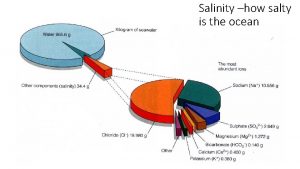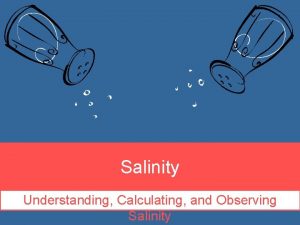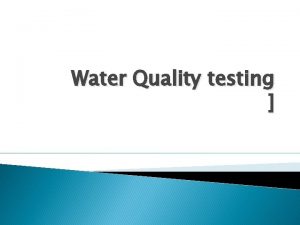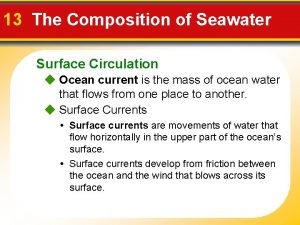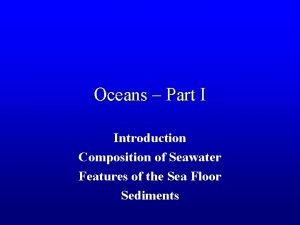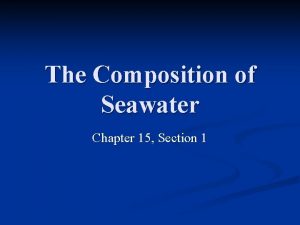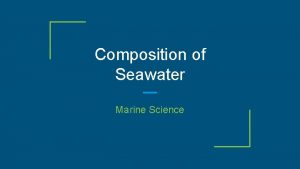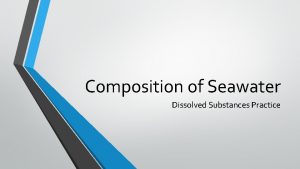15 1 The Composition of Seawater Salinity is




































- Slides: 36

15. 1 The Composition of Seawater Salinity is the total amount of solid material dissolved in water. Because the proportion of dissolved substances in seawater is such a small number, oceanographers typically express salinity in parts per thousands. Most of the salt in seawater is sodium chloride, common table salt.

15. 1 The Composition of Seawater Salinity Sources of Sea Salt • Chemical weathering of rocks on the continents is one source of elements found in seawater. • The second major source of elements found in seawater is from Earth’s interior.

Salts in Seawater

15. 1 The Composition of Seawater Salinity Processes Affecting Salinity • Processes that decrease salinity: - Precipitation - Sea ice melting - Icebergs melting - Runoff from land • Processes that increase salinity: - Evaporation - Formation of sea ice

Natural Processes Affecting Salinity

15. 1 The Composition of Seawater Ocean Temperature Variation The ocean’s surface water temperature varies with the amount of solar radiation received, which is primarily a function of latitude. Temperature Variation with Depth • The thermocline is the layer of ocean water between about 300 meters and 1000 meters where there is a rapid change of temperature with depth. • The thermocline is a very important structure because it creates a barrier to marine life.

Variations in Ocean Surface Temperature

Variations in Ocean Water Temperature

15. 1 The Composition of Seawater Ocean Density Variation Density is defined as mass per unit volume. It can be thought of as a measure of how heavy something is for its size. Factors Affecting Seawater Density • Seawater density is influenced by two main factors: salinity and temperature.

15. 1 The Composition of Seawater Ocean Density Variation with Depth • The pycnocline is the layer of ocean water between about 300 meters and 1000 meters where there is a rapid change of density with depth.

Variations in Ocean Water Density

15. 1 The Composition of Seawater Ocean Layering Oceanographers generally recognize a three-layered structure in most parts of the open ocean: a shallow surface mixed zone, a transition zone, and a deep zone. Surface Zone • Shallow (300 to 450 meters) • Zone of mixing • Sun-warmed zone

15. 1 The Composition of Seawater Ocean Layering Transition Zone • Between surface layer and deep zone • Thermocline and pycnocline Deep Zone • Sunlight never reaches this zone. • Temperatures are just a few degrees above freezing. • Constant high-density water

Ocean Zones

15. 2 The Diversity of Ocean Life Classification of Marine Organisms Marine organisms can be classified according to where they live and how they move. Plankton • Plankton include all organisms—algae, animals, and bacteria—that drift with ocean currents. • Phytoplankton are algal plankton, which are the most important community of primary producers in the ocean. • Zooplankton are animal plankton.

Plankton

15. 2 The Diversity of Ocean Life Classification of Marine Organisms Nekton • Nekton include all animals capable of moving independently of the ocean currents, by swimming or other means of propulsion. Benthos • Benthos describes organisms living on or in the ocean bottom.

Nekton

Benthos

15. 2 The Diversity of Ocean Life Marine Life Zones Three factors are used to divide the ocean into distinct marine life zones: the availability of sunlight, the distance from shore, and the water depth. Availability of Sunlight • The photic zone is the upper part of the ocean into which sunlight penetrates.

15. 2 The Diversity of Ocean Life Marine Life Zones Distance from Shore • The intertidal zone is the strip of land where the land ocean meet and overlap, or the zone between high and low tides. • The neritic zone is the marine-life zone that extends from the low-tide line out to the shelf break. • The oceanic zone is the marine-life zone beyond the continental shelf.

Marine Life Zones

15. 2 The Diversity of Ocean Life Marine Life Zones Water Depth • The pelagic zone is open zone of any depth. Animals in this zone swim or float freely. • The benthic zone is the marine-life zone that includes any sea-bottom surface regardless of its distance from shore. • The abyssal zone is a subdivision of the benthic zone characterized by extremely high pressures, low temperatures, low oxygen, few nutrients, and no sunlight.

15. 2 The Diversity of Ocean Life Marine Life Zones Hydrothermal Vents • Here seawater seeps into the ocean floor through cracks in the crust. • At some vents, water temperatures of 100 o. C or higher support communities of organisms found nowhere else in the world.

Hydrothermal Vents

Tube Worms Found Along Hydrothermal Vents

15. 3 Oceanic Productivity Primary Productivity Primary productivity is the production of organic compounds from inorganic substances through photosynthesis or chemosynthesis. Photosynthesis is the use of light energy to convert water and carbon dioxide into energy-rich glucose molecules. Chemosynthesis is the process by which certain microorganisms create organic molecules from inorganic nutrients using chemical energy.

Productivity in the Barents Sea

15. 3 Oceanic Productivity Primary Productivity in Polar Oceans • The low availability of solar energy limits photosynthetic productivity in polar areas. Productivity in Tropical Oceans • Productivity in tropical regions is limited by the lack of nutrients.

Water Layers in the Tropics

15. 3 Oceanic Productivity Primary Productivity in Temperate Oceans • In temperate regions, which are found at midlatitudes, a combination of these two limiting factors, sunlight and nutrient supply, controls productivity. • Winter - Low productivity - Days are short and sun angle is low.

Productivity in Northern Hemisphere, Temperate Oceans

15. 3 Oceanic Productivity Primary Productivity in Temperate Oceans • Spring - Spring bloom of phytoplankton is quickly depleted. - Productivity is limited. • Summer - Strong thermocline develops so surface nutrients are not replaced from below. - Phytoplankton population remains relatively low.

15. 3 Oceanic Productivity Oceanic Feeding Relationships Trophic Levels • A trophic level is a nourishment level in a food chain. Plant and algae producers constitute the lowest level, followed by herbivores and a series of carnivores at progressively higher levels. Transfer Efficiency • The transfer of energy between trophic levels is very inefficient.

15. 3 Oceanic Productivity Oceanic Feeding Relationships Food Chains and Food Webs • A food chain is a sequence of organisms through which energy is transferred, starting with the primary producer. • A food web is a group of interrelated food chains. • Animals that feed through a food web rather than a food chain are more likely to survive because they have alternative foods to eat should one of their food sources diminish or disappear.

Food Chains and Webs
 Composition seawater
Composition seawater Water logging and salinity
Water logging and salinity Messinian salinity crisis
Messinian salinity crisis Mung bean salinity experiment
Mung bean salinity experiment Salinity
Salinity Salinity unit of measurement
Salinity unit of measurement Salinity vertical profile
Salinity vertical profile Dead sea salinity ppt
Dead sea salinity ppt Characteristics of pure water
Characteristics of pure water Specific volume units
Specific volume units Great salt lake salinity
Great salt lake salinity Gambar bendungan
Gambar bendungan Trace elements in seawater
Trace elements in seawater Bromine from sea water
Bromine from sea water Boiling point of seawater
Boiling point of seawater Chemical properties of seawater
Chemical properties of seawater 101012 bằng
101012 bằng Thơ thất ngôn tứ tuyệt đường luật
Thơ thất ngôn tứ tuyệt đường luật Chúa yêu trần thế
Chúa yêu trần thế Hổ sinh sản vào mùa nào
Hổ sinh sản vào mùa nào đại từ thay thế
đại từ thay thế Diễn thế sinh thái là
Diễn thế sinh thái là Vẽ hình chiếu vuông góc của vật thể sau
Vẽ hình chiếu vuông góc của vật thể sau Công thức tính độ biến thiên đông lượng
Công thức tính độ biến thiên đông lượng Thế nào là mạng điện lắp đặt kiểu nổi
Thế nào là mạng điện lắp đặt kiểu nổi Tỉ lệ cơ thể trẻ em
Tỉ lệ cơ thể trẻ em Lời thề hippocrates
Lời thề hippocrates Vẽ hình chiếu đứng bằng cạnh của vật thể
Vẽ hình chiếu đứng bằng cạnh của vật thể Quá trình desamine hóa có thể tạo ra
Quá trình desamine hóa có thể tạo ra Các môn thể thao bắt đầu bằng tiếng bóng
Các môn thể thao bắt đầu bằng tiếng bóng Hát kết hợp bộ gõ cơ thể
Hát kết hợp bộ gõ cơ thể Khi nào hổ con có thể sống độc lập
Khi nào hổ con có thể sống độc lập điện thế nghỉ
điện thế nghỉ Các loại đột biến cấu trúc nhiễm sắc thể
Các loại đột biến cấu trúc nhiễm sắc thể Nguyên nhân của sự mỏi cơ sinh 8
Nguyên nhân của sự mỏi cơ sinh 8 độ dài liên kết
độ dài liên kết Trời xanh đây là của chúng ta thể thơ
Trời xanh đây là của chúng ta thể thơ
